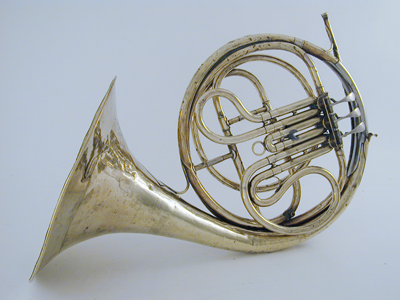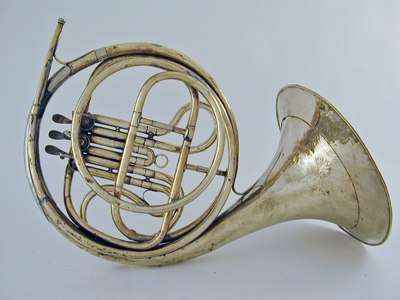August Bopp or Popp (1836 - ca.1914)) was born in Neckersulm, Germany on August 25, 1836. He located in Munich by 1864 where he was granted trading rights in 1869 as a maker of brass instruments. According to the Zeitschrift für Instrumentenbau Bopp provided two Bach trumpets for a performance of a Bach Mass by the Musikalishce Academie of Munich in 1889. In the opinion of "authoritative experts" at the time, the instruments fit the whole context of the work by their characteristic tone color. He also was said to have made antiquarian instruments including Greek horns and tubas "manufactured in their peculiar form and their beautiful soft sound generally caused a stir." He continued in Munich until about 1914, when he was succeeded by Anton Schöpf, Jr. (1886 - 1931). Schöpf had probably been trained by his father, Anton, Sr. (1861 - 1931), who was also a brass instrument and clockspring maker in Munich. |
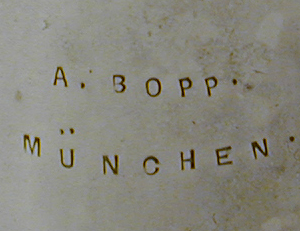 |
In the photos above, the horn has an F crook in the tuning slide. It was also supplied with two additional crooks in G and A as seen in the photos at the right. According to one source, Max Hess preferred the G crook, although others state that he played an F horn (see below). Quite probably he selected the crook that best fit the tonality of the literature. For sharp keys he might prefer the G crook since it has one "built-in" sharp, and simplifies the fingerings for sharp keys, whereas, the F crook has one "built-in" flat and is better suited to flat keys. The F and G crooks are pretty well in tune at modern pitch, however the A crook plays quite flat. |
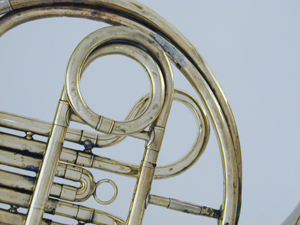 G Crook 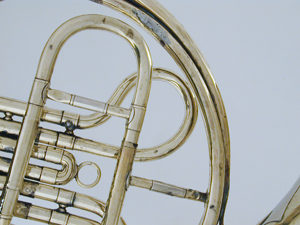 A Crook |
As shown in the photos at the right, the first and third valve tuning slides from the Bopp horn are wrapped somewhat wider than those that have become almost universally standard from other makers. Another distinctive characteristic is the manner in which the valve lever saddle is mounted on the tops of the valve casings as shown in the photo below, left. The photo below right shows the very wide and undecorated bell garland, designed to prevent the tone from becoming harsh or "brassy" in loud passages. |
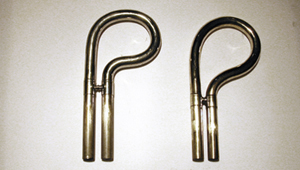 <-Kruspe - Bopp-> 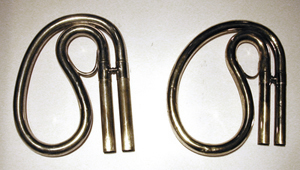 <-Kruspe - Bopp-> |
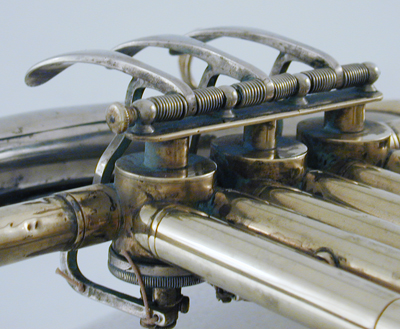 |
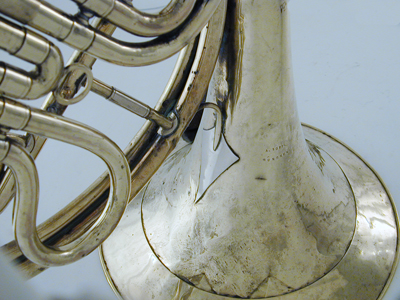 |
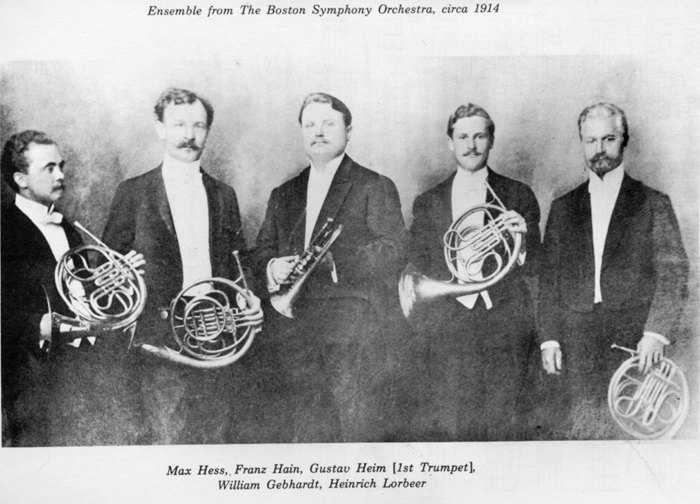 The "Waldhorn Quartette" of the Boston Symphony Orchestra and cornet soloist, Gustav Heim. Max Hess and William Gephardt are holding horns by August Bopp similar to the one shown above. The horn held by Heinrich Lorbeer is also a Bopp single, but a slightly different model (see photos at the bottom of the page). It has some of the same distinctive characteristics of the subject horn, including the first valve slide and placement of the valve lever saddle on top of the valve casings. |
|
Max Gustav Hess (1878 - 1975) was born March 1, 1878 in Klingenthal, Germany. He studied horn with Friedrich Gumpert at the Leipzig Conservatory from 1896 to 1899. Following those studies, Hess served as first horn with the Operas at Rostock and Frankfurt-am-Main, before joining the Gürzenich Orchestra in Cologne. It was with this orchestra that he performed the premier performance of the Fifth Symphony by Gustav Mahler, under the composer' direction on October 18, 1904.The symphony is a tour-de-force for the horn section and features the now well-known third movement (Scherzo) obligato for solo horn. Mahler said of it "The Scherzo is a devil of a movement! What a long and painful history awaits it!" At that time Hess was playing a single horn by August Bopp, very similar to the subject horn described above. A year later, Hess arrived in the United States on October 3, 1905 to join the Boston Symphony Orchestra by invitation. That first season with the BSO he again played Mahler's Fifth Symphony with the BSO in Boston, New York, and Philadelphia, in February, 1906. Hess was still using the Bopp single horn which he continued to play until about 1913, when he changed to an Alexander double horn. |
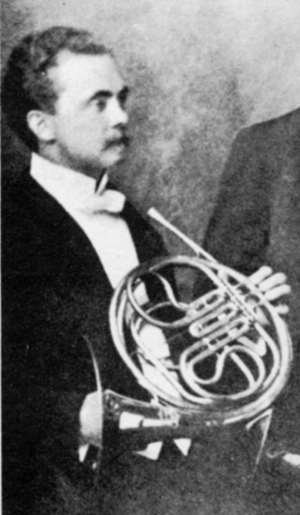 |
The quartet's second horn, Franz Hain was born in Terplitz, Bohemia. He began to study music at the ages of seven, and at fourteen became a student in the Conservatory of Prague. The following year he was engaged as the first hornist in the Genebehaus and Phihlarmonic Orchestras, under Nicode, afterwards as first hornist in the Philharmonic at Hamburg and at Carlsbad. While holding this position he was engaged for the position of third horn in the Boston Symphony Orchestra. |
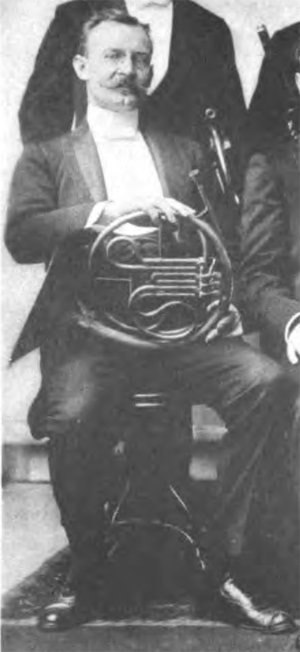 |
William Gephardt was born on December 5, 1884, shortly after his parents had moved to Boston. His father tried to encourage him to play the violin at the age of ten, however, he showed little interest. Meanwhile, his grandmother in New York had a paying guest-a horn player in the Metropolitan Opera Orchestra. The guest left suddenly and neglected to pay. In recompense, he left his horn behind in his room . The grandmother thought it was a bugle, and no matter how hard she tried to blow it she could not make a sound, so she sent it to William. Mr. Gebhardt sent his son to Albert Hackebarth, then a member of the Boston Symphony, for lessons. He studied for five years, then joined the Boston Symphony in 1907 as second horn. He left at the end of the 1912 - 1913 season. He played third horn in the St. Louis Symphony Orchestra from 1914 to 1915, as well as the Maine Festival Orchestra. From 1918 to 1924 , he was the fourth hornist in the section of the Boston Symphony Orchestra, and second horn there from 1924 to 1926. The next year he was fourth again, and then returned to St. Louis to play fourth horn from 1928 to 1933. After that he returned to Boston once more to play until his retirement in 1948. However, he came out of retirement in 1952 to play fourth horn in the Substitute Boston Symphony while the regular orchestra was on tour. Mr. Valkenier, now 93 years old, recalls that William Gebhartdt died well over ten years ago where he lived in Stoughton, Mass. He is remembered as the man who revised and augmented the well-known Complete Method for the French Horn by Oscar Franz, published by Cundy-Bettony Co., Inc., Boston, 1942. |
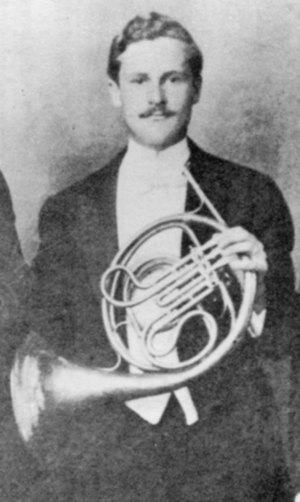 |
Heinrich Lorbeer was born in Welda Germany on 1865. At the age of twelve he began the study of the violin, and two years later took up the horn. In 1882 he attended the Leipzig Conservatory, studying horn with Friedrich Gumpert, piano with Alois Reckendorf (1841–1911), and composition with Salomon Jadassohn (1831-1902). In the spring of 1885 he was engaged to play in the concerts of the zoological garden at St. Petersburg. The following Fall he returned to Leipzig where he was engaged as fourth horn in the Gewandhaus Orchestra under Carl Reinecke (1824-1910) and the Opera, under directors Arthur Nikisch (1855-1922) and Emil Paur (1855.1932), and second conductors, Gustav Mahler (1860-1911) and Gustav Kogel (1849-1921). In 1891 Nikisch invited him to join the Boston Symphony Orchestra. Mr. Lorbeer served the BSO as second horn through the 1922-23 season, then moved to fourth horn until his retirement at the end of the 1936-37 season. BSO biographer, Gerome Brush, had this to say about Mr. Lorbeer:"When the Lion and the Lamb lay down together, they must have lain down in Mr. Lobeer's heart. He is like Wotan, a great and beneficent presence, a mighty rock that casts a gentile shadow. At the age of 71 hes a giant of strength; he can swim for miles. He is the iron man of this orchestra. His service of 45 unbroken years is a Boston Symphony record, and probably unequaled elsewhere.Longtime BSO viola player, George Norwood Humphrey, tells the following anecdote about Mr. Lorbeer:"One of our newer players had made a very bad showing in the Siegfried Horn Call in a recent performance. In the tuning room, we were being bombarded by this call from the new player. He could negotiate everything but the top high note...Sitting at one of our tables playing cards was Lorbeer our oldest horn player. He had been a very famous player, now playing fourth horn, responsible for the very lowest notes on the instrument. Without laying down his cards, Lorbeer took his horn in one hand, raised the instrument to his lips, and played the very high note that had given the young player so much trouble. He then put the horn down. We never heard the horn call again during our tuning moments." |
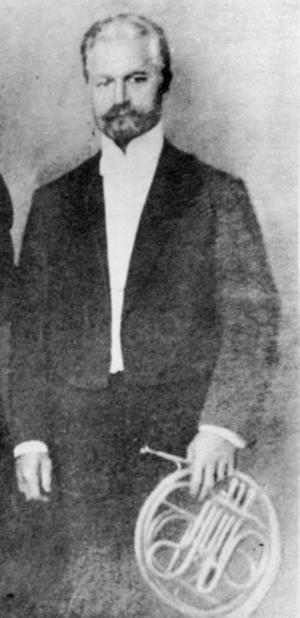 |
The horn Mr. Lorbeer is holding is undoubtedly an August Bopp single, however it is a slightly different model than the one used by Max Hess and William Gebhardt. The only observable difference is the configuration of the third valve slide. This horn is similar to the Bopp horn shown in the photos at right and below (courtesy of William Melton). Note also the applied medallion on the side of the bell identifying August Bopp as the maker in the photo at right. This medallion is also visible in the photo of the horn held by Max Hess, above. |
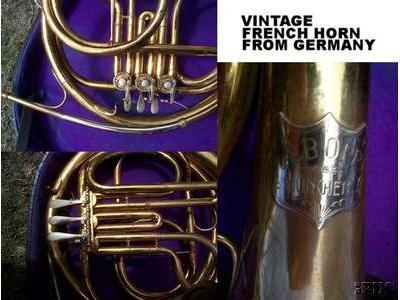 |
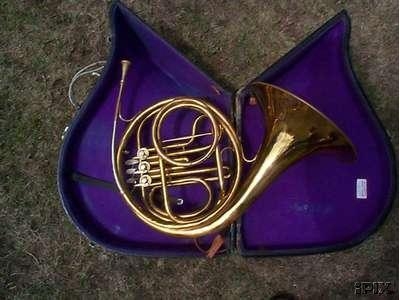 |
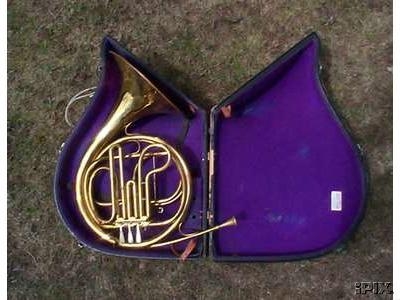 |
